Business Strategy Analysis: Deere & Company Case Study Report
VerifiedAdded on 2020/05/16
|13
|2110
|94
Report
AI Summary
This report offers a comprehensive analysis of Deere & Company's business strategy, focusing on its external environment and competitive dynamics. The report begins with an overview of the company, followed by an evaluation of its strategy using financial ratios like current ratio, net margin ratio, and debt-equity ratio, revealing insights into its liquidity, profitability, and solvency. The analysis extends to the external environment, employing PESTLE and Porter's Five Forces frameworks to assess political, economic, socio-cultural, technological, environmental, and legal factors, as well as the bargaining power of buyers and suppliers, competitive rivalry, and threats of substitutes and new entrants. The competitive rivalry section highlights key competitors like CNH Industrial N.V. and AGCO Corporation. The report concludes by summarizing the company's position and providing recommendations for improvement and expansion, particularly in emerging markets. The study references key data from 2013-2015 reports to support its findings.

Business Strategy
Deere & Company
Deere & Company
Paraphrase This Document
Need a fresh take? Get an instant paraphrase of this document with our AI Paraphraser
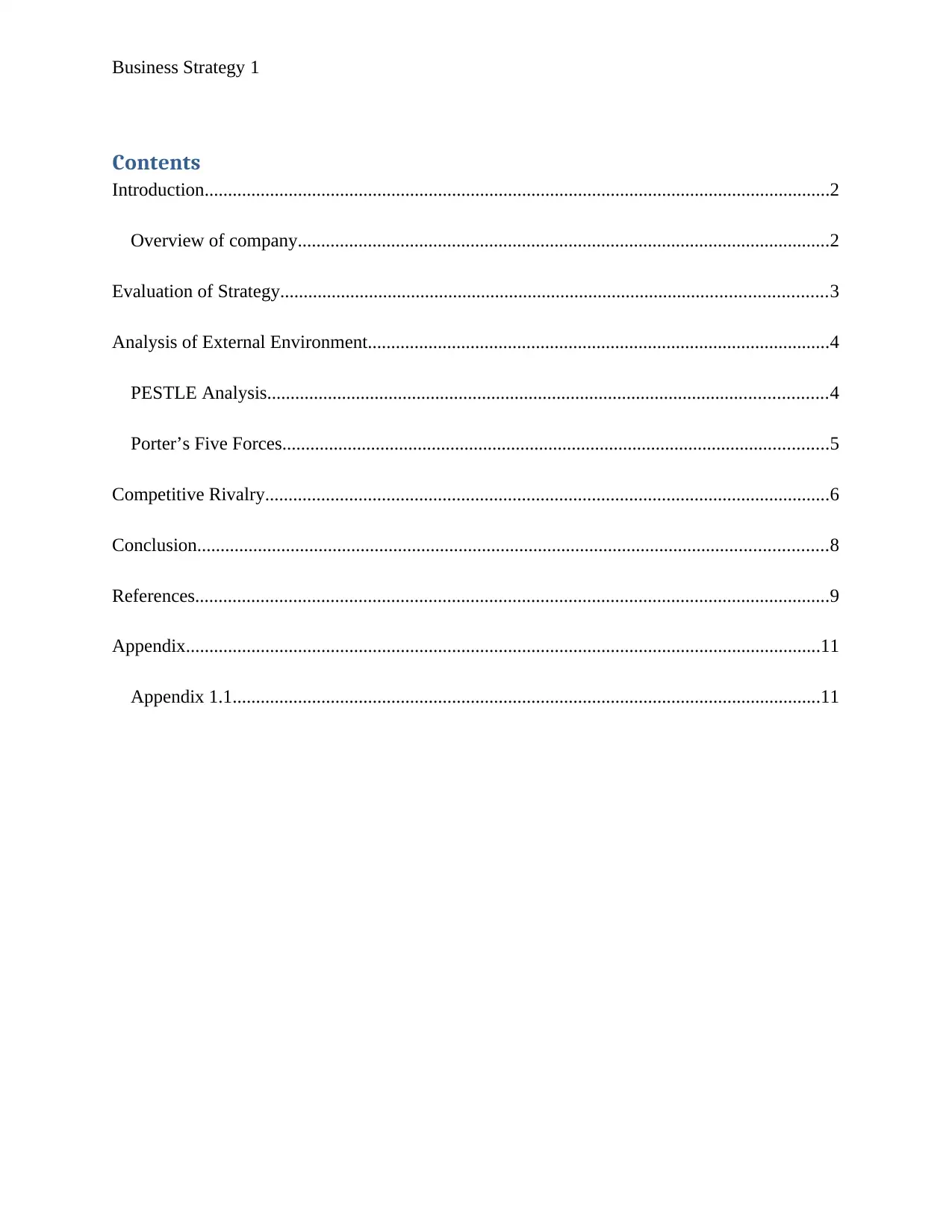
Business Strategy 1
Contents
Introduction......................................................................................................................................2
Overview of company..................................................................................................................2
Evaluation of Strategy.....................................................................................................................3
Analysis of External Environment...................................................................................................4
PESTLE Analysis........................................................................................................................4
Porter’s Five Forces.....................................................................................................................5
Competitive Rivalry.........................................................................................................................6
Conclusion.......................................................................................................................................8
References........................................................................................................................................9
Appendix........................................................................................................................................11
Appendix 1.1..............................................................................................................................11
Contents
Introduction......................................................................................................................................2
Overview of company..................................................................................................................2
Evaluation of Strategy.....................................................................................................................3
Analysis of External Environment...................................................................................................4
PESTLE Analysis........................................................................................................................4
Porter’s Five Forces.....................................................................................................................5
Competitive Rivalry.........................................................................................................................6
Conclusion.......................................................................................................................................8
References........................................................................................................................................9
Appendix........................................................................................................................................11
Appendix 1.1..............................................................................................................................11
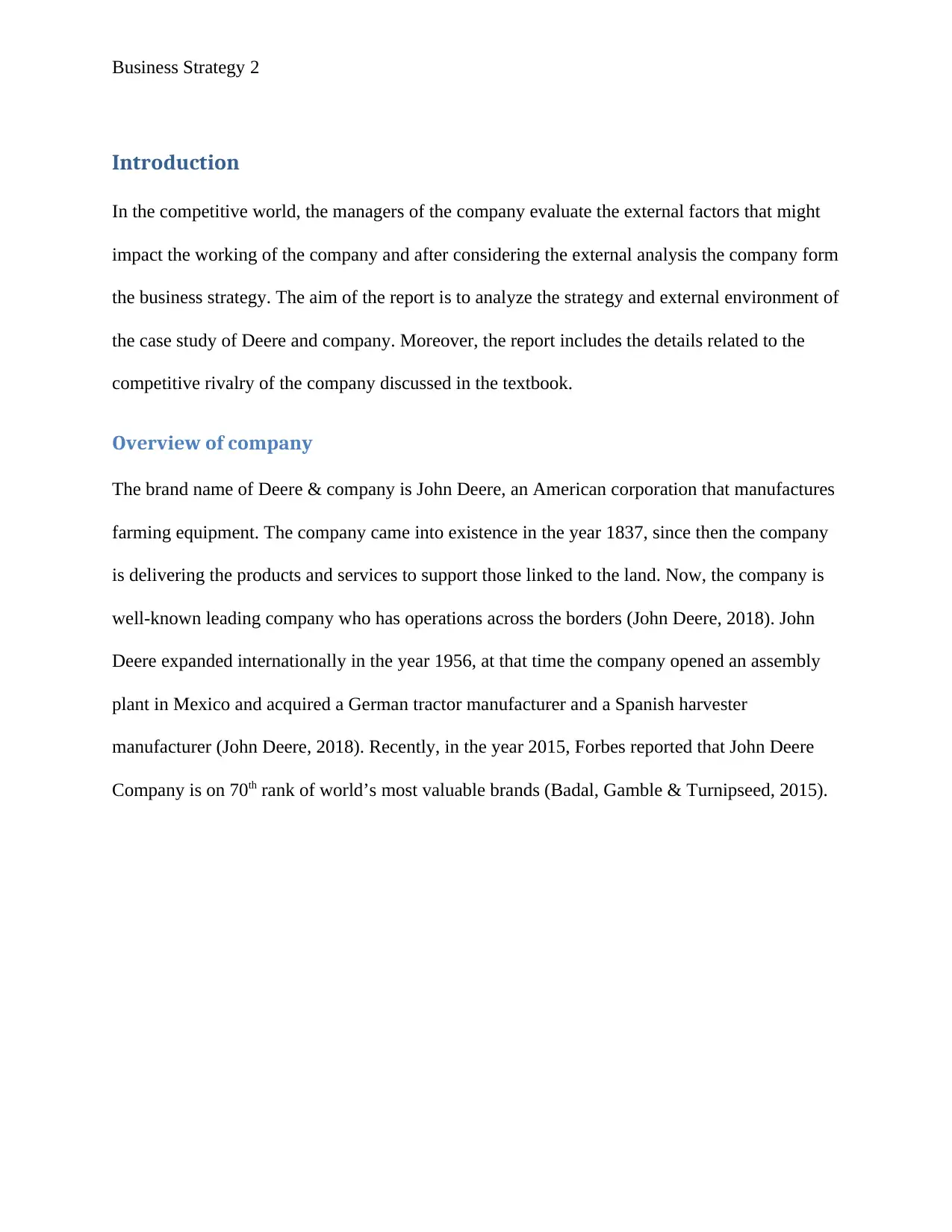
Business Strategy 2
Introduction
In the competitive world, the managers of the company evaluate the external factors that might
impact the working of the company and after considering the external analysis the company form
the business strategy. The aim of the report is to analyze the strategy and external environment of
the case study of Deere and company. Moreover, the report includes the details related to the
competitive rivalry of the company discussed in the textbook.
Overview of company
The brand name of Deere & company is John Deere, an American corporation that manufactures
farming equipment. The company came into existence in the year 1837, since then the company
is delivering the products and services to support those linked to the land. Now, the company is
well-known leading company who has operations across the borders (John Deere, 2018). John
Deere expanded internationally in the year 1956, at that time the company opened an assembly
plant in Mexico and acquired a German tractor manufacturer and a Spanish harvester
manufacturer (John Deere, 2018). Recently, in the year 2015, Forbes reported that John Deere
Company is on 70th rank of world’s most valuable brands (Badal, Gamble & Turnipseed, 2015).
Introduction
In the competitive world, the managers of the company evaluate the external factors that might
impact the working of the company and after considering the external analysis the company form
the business strategy. The aim of the report is to analyze the strategy and external environment of
the case study of Deere and company. Moreover, the report includes the details related to the
competitive rivalry of the company discussed in the textbook.
Overview of company
The brand name of Deere & company is John Deere, an American corporation that manufactures
farming equipment. The company came into existence in the year 1837, since then the company
is delivering the products and services to support those linked to the land. Now, the company is
well-known leading company who has operations across the borders (John Deere, 2018). John
Deere expanded internationally in the year 1956, at that time the company opened an assembly
plant in Mexico and acquired a German tractor manufacturer and a Spanish harvester
manufacturer (John Deere, 2018). Recently, in the year 2015, Forbes reported that John Deere
Company is on 70th rank of world’s most valuable brands (Badal, Gamble & Turnipseed, 2015).
⊘ This is a preview!⊘
Do you want full access?
Subscribe today to unlock all pages.

Trusted by 1+ million students worldwide
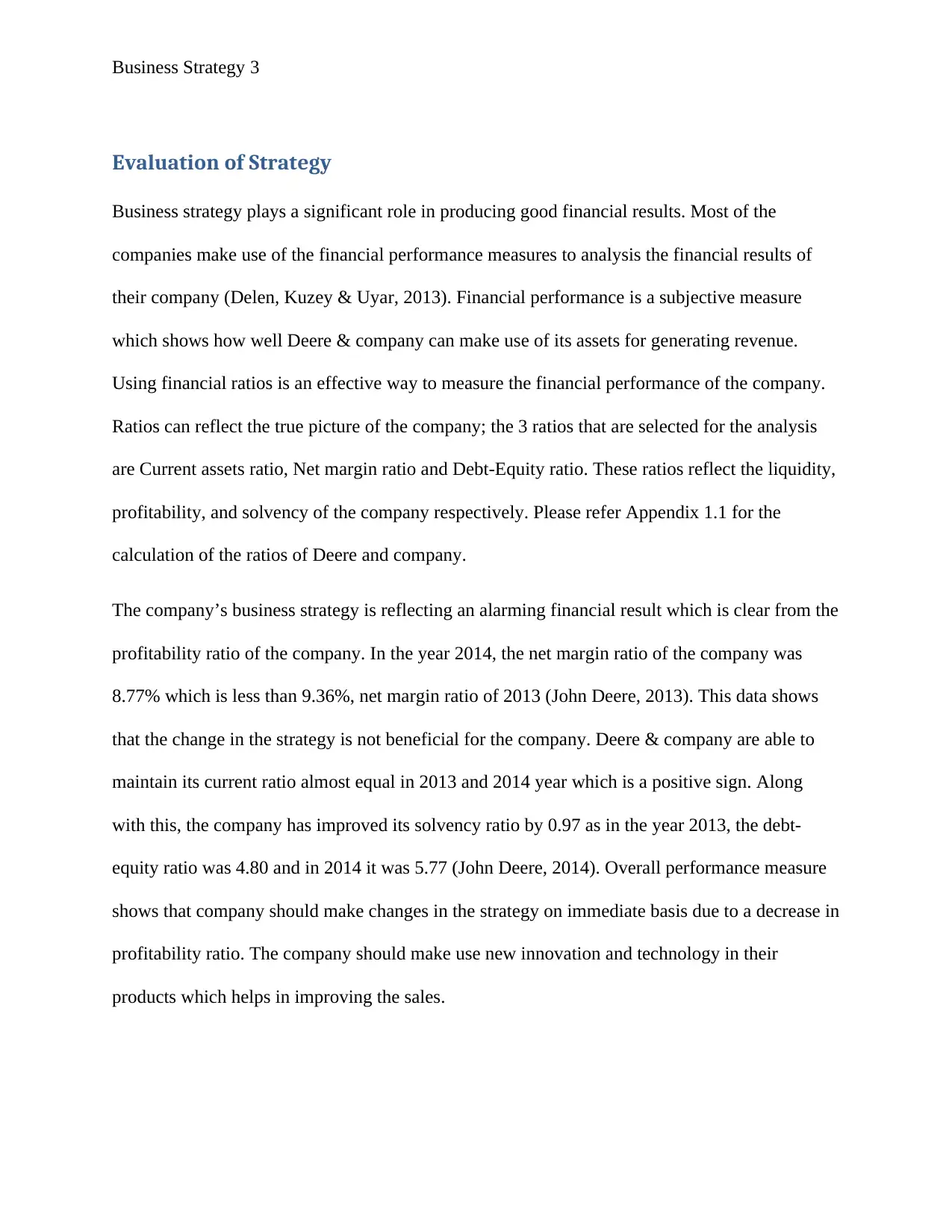
Business Strategy 3
Evaluation of Strategy
Business strategy plays a significant role in producing good financial results. Most of the
companies make use of the financial performance measures to analysis the financial results of
their company (Delen, Kuzey & Uyar, 2013). Financial performance is a subjective measure
which shows how well Deere & company can make use of its assets for generating revenue.
Using financial ratios is an effective way to measure the financial performance of the company.
Ratios can reflect the true picture of the company; the 3 ratios that are selected for the analysis
are Current assets ratio, Net margin ratio and Debt-Equity ratio. These ratios reflect the liquidity,
profitability, and solvency of the company respectively. Please refer Appendix 1.1 for the
calculation of the ratios of Deere and company.
The company’s business strategy is reflecting an alarming financial result which is clear from the
profitability ratio of the company. In the year 2014, the net margin ratio of the company was
8.77% which is less than 9.36%, net margin ratio of 2013 (John Deere, 2013). This data shows
that the change in the strategy is not beneficial for the company. Deere & company are able to
maintain its current ratio almost equal in 2013 and 2014 year which is a positive sign. Along
with this, the company has improved its solvency ratio by 0.97 as in the year 2013, the debt-
equity ratio was 4.80 and in 2014 it was 5.77 (John Deere, 2014). Overall performance measure
shows that company should make changes in the strategy on immediate basis due to a decrease in
profitability ratio. The company should make use new innovation and technology in their
products which helps in improving the sales.
Evaluation of Strategy
Business strategy plays a significant role in producing good financial results. Most of the
companies make use of the financial performance measures to analysis the financial results of
their company (Delen, Kuzey & Uyar, 2013). Financial performance is a subjective measure
which shows how well Deere & company can make use of its assets for generating revenue.
Using financial ratios is an effective way to measure the financial performance of the company.
Ratios can reflect the true picture of the company; the 3 ratios that are selected for the analysis
are Current assets ratio, Net margin ratio and Debt-Equity ratio. These ratios reflect the liquidity,
profitability, and solvency of the company respectively. Please refer Appendix 1.1 for the
calculation of the ratios of Deere and company.
The company’s business strategy is reflecting an alarming financial result which is clear from the
profitability ratio of the company. In the year 2014, the net margin ratio of the company was
8.77% which is less than 9.36%, net margin ratio of 2013 (John Deere, 2013). This data shows
that the change in the strategy is not beneficial for the company. Deere & company are able to
maintain its current ratio almost equal in 2013 and 2014 year which is a positive sign. Along
with this, the company has improved its solvency ratio by 0.97 as in the year 2013, the debt-
equity ratio was 4.80 and in 2014 it was 5.77 (John Deere, 2014). Overall performance measure
shows that company should make changes in the strategy on immediate basis due to a decrease in
profitability ratio. The company should make use new innovation and technology in their
products which helps in improving the sales.
Paraphrase This Document
Need a fresh take? Get an instant paraphrase of this document with our AI Paraphraser
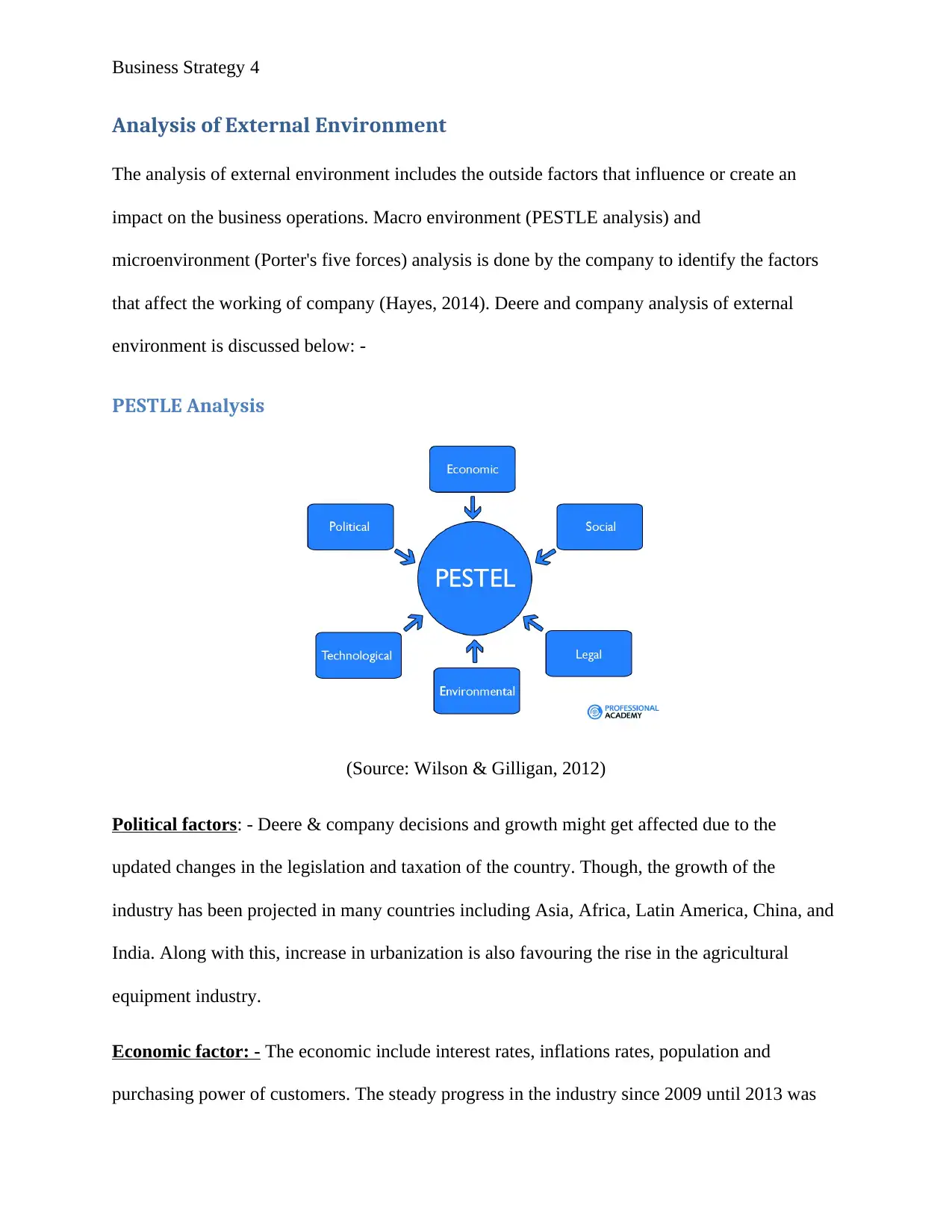
Business Strategy 4
Analysis of External Environment
The analysis of external environment includes the outside factors that influence or create an
impact on the business operations. Macro environment (PESTLE analysis) and
microenvironment (Porter's five forces) analysis is done by the company to identify the factors
that affect the working of company (Hayes, 2014). Deere and company analysis of external
environment is discussed below: -
PESTLE Analysis
(Source: Wilson & Gilligan, 2012)
Political factors: - Deere & company decisions and growth might get affected due to the
updated changes in the legislation and taxation of the country. Though, the growth of the
industry has been projected in many countries including Asia, Africa, Latin America, China, and
India. Along with this, increase in urbanization is also favouring the rise in the agricultural
equipment industry.
Economic factor: - The economic include interest rates, inflations rates, population and
purchasing power of customers. The steady progress in the industry since 2009 until 2013 was
Analysis of External Environment
The analysis of external environment includes the outside factors that influence or create an
impact on the business operations. Macro environment (PESTLE analysis) and
microenvironment (Porter's five forces) analysis is done by the company to identify the factors
that affect the working of company (Hayes, 2014). Deere and company analysis of external
environment is discussed below: -
PESTLE Analysis
(Source: Wilson & Gilligan, 2012)
Political factors: - Deere & company decisions and growth might get affected due to the
updated changes in the legislation and taxation of the country. Though, the growth of the
industry has been projected in many countries including Asia, Africa, Latin America, China, and
India. Along with this, increase in urbanization is also favouring the rise in the agricultural
equipment industry.
Economic factor: - The economic include interest rates, inflations rates, population and
purchasing power of customers. The steady progress in the industry since 2009 until 2013 was
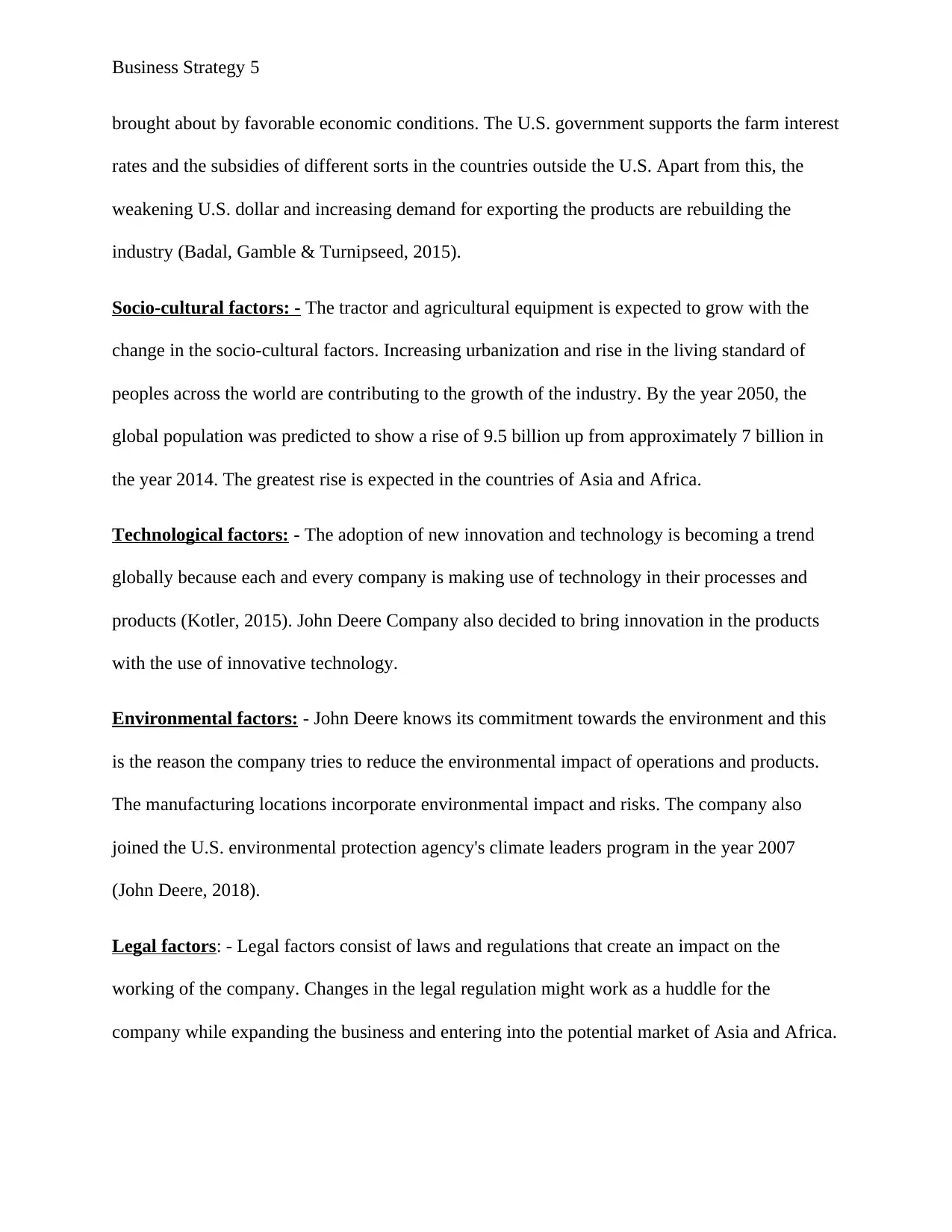
Business Strategy 5
brought about by favorable economic conditions. The U.S. government supports the farm interest
rates and the subsidies of different sorts in the countries outside the U.S. Apart from this, the
weakening U.S. dollar and increasing demand for exporting the products are rebuilding the
industry (Badal, Gamble & Turnipseed, 2015).
Socio-cultural factors: - The tractor and agricultural equipment is expected to grow with the
change in the socio-cultural factors. Increasing urbanization and rise in the living standard of
peoples across the world are contributing to the growth of the industry. By the year 2050, the
global population was predicted to show a rise of 9.5 billion up from approximately 7 billion in
the year 2014. The greatest rise is expected in the countries of Asia and Africa.
Technological factors: - The adoption of new innovation and technology is becoming a trend
globally because each and every company is making use of technology in their processes and
products (Kotler, 2015). John Deere Company also decided to bring innovation in the products
with the use of innovative technology.
Environmental factors: - John Deere knows its commitment towards the environment and this
is the reason the company tries to reduce the environmental impact of operations and products.
The manufacturing locations incorporate environmental impact and risks. The company also
joined the U.S. environmental protection agency's climate leaders program in the year 2007
(John Deere, 2018).
Legal factors: - Legal factors consist of laws and regulations that create an impact on the
working of the company. Changes in the legal regulation might work as a huddle for the
company while expanding the business and entering into the potential market of Asia and Africa.
brought about by favorable economic conditions. The U.S. government supports the farm interest
rates and the subsidies of different sorts in the countries outside the U.S. Apart from this, the
weakening U.S. dollar and increasing demand for exporting the products are rebuilding the
industry (Badal, Gamble & Turnipseed, 2015).
Socio-cultural factors: - The tractor and agricultural equipment is expected to grow with the
change in the socio-cultural factors. Increasing urbanization and rise in the living standard of
peoples across the world are contributing to the growth of the industry. By the year 2050, the
global population was predicted to show a rise of 9.5 billion up from approximately 7 billion in
the year 2014. The greatest rise is expected in the countries of Asia and Africa.
Technological factors: - The adoption of new innovation and technology is becoming a trend
globally because each and every company is making use of technology in their processes and
products (Kotler, 2015). John Deere Company also decided to bring innovation in the products
with the use of innovative technology.
Environmental factors: - John Deere knows its commitment towards the environment and this
is the reason the company tries to reduce the environmental impact of operations and products.
The manufacturing locations incorporate environmental impact and risks. The company also
joined the U.S. environmental protection agency's climate leaders program in the year 2007
(John Deere, 2018).
Legal factors: - Legal factors consist of laws and regulations that create an impact on the
working of the company. Changes in the legal regulation might work as a huddle for the
company while expanding the business and entering into the potential market of Asia and Africa.
⊘ This is a preview!⊘
Do you want full access?
Subscribe today to unlock all pages.

Trusted by 1+ million students worldwide
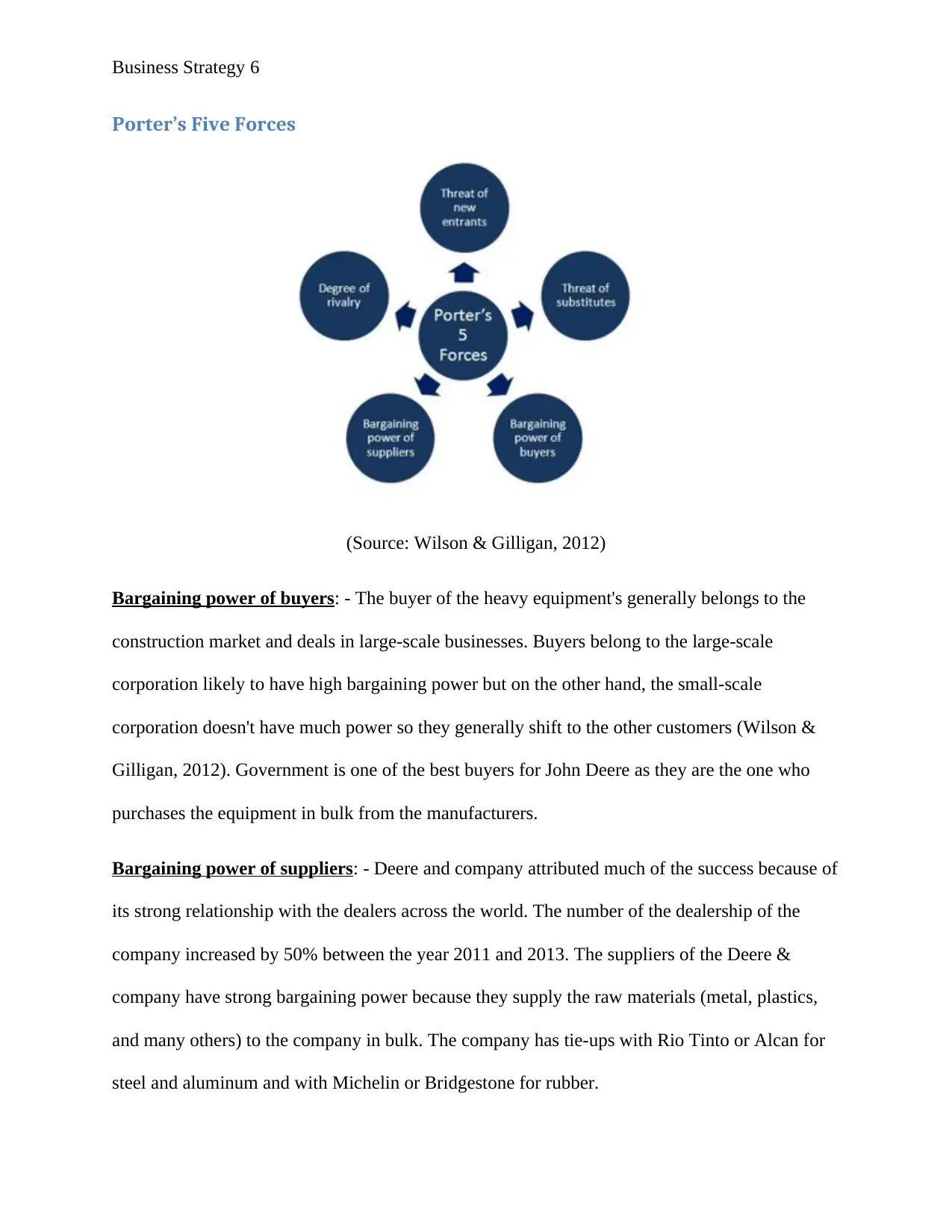
Business Strategy 6
Porter’s Five Forces
(Source: Wilson & Gilligan, 2012)
Bargaining power of buyers: - The buyer of the heavy equipment's generally belongs to the
construction market and deals in large-scale businesses. Buyers belong to the large-scale
corporation likely to have high bargaining power but on the other hand, the small-scale
corporation doesn't have much power so they generally shift to the other customers (Wilson &
Gilligan, 2012). Government is one of the best buyers for John Deere as they are the one who
purchases the equipment in bulk from the manufacturers.
Bargaining power of suppliers: - Deere and company attributed much of the success because of
its strong relationship with the dealers across the world. The number of the dealership of the
company increased by 50% between the year 2011 and 2013. The suppliers of the Deere &
company have strong bargaining power because they supply the raw materials (metal, plastics,
and many others) to the company in bulk. The company has tie-ups with Rio Tinto or Alcan for
steel and aluminum and with Michelin or Bridgestone for rubber.
Porter’s Five Forces
(Source: Wilson & Gilligan, 2012)
Bargaining power of buyers: - The buyer of the heavy equipment's generally belongs to the
construction market and deals in large-scale businesses. Buyers belong to the large-scale
corporation likely to have high bargaining power but on the other hand, the small-scale
corporation doesn't have much power so they generally shift to the other customers (Wilson &
Gilligan, 2012). Government is one of the best buyers for John Deere as they are the one who
purchases the equipment in bulk from the manufacturers.
Bargaining power of suppliers: - Deere and company attributed much of the success because of
its strong relationship with the dealers across the world. The number of the dealership of the
company increased by 50% between the year 2011 and 2013. The suppliers of the Deere &
company have strong bargaining power because they supply the raw materials (metal, plastics,
and many others) to the company in bulk. The company has tie-ups with Rio Tinto or Alcan for
steel and aluminum and with Michelin or Bridgestone for rubber.
Paraphrase This Document
Need a fresh take? Get an instant paraphrase of this document with our AI Paraphraser
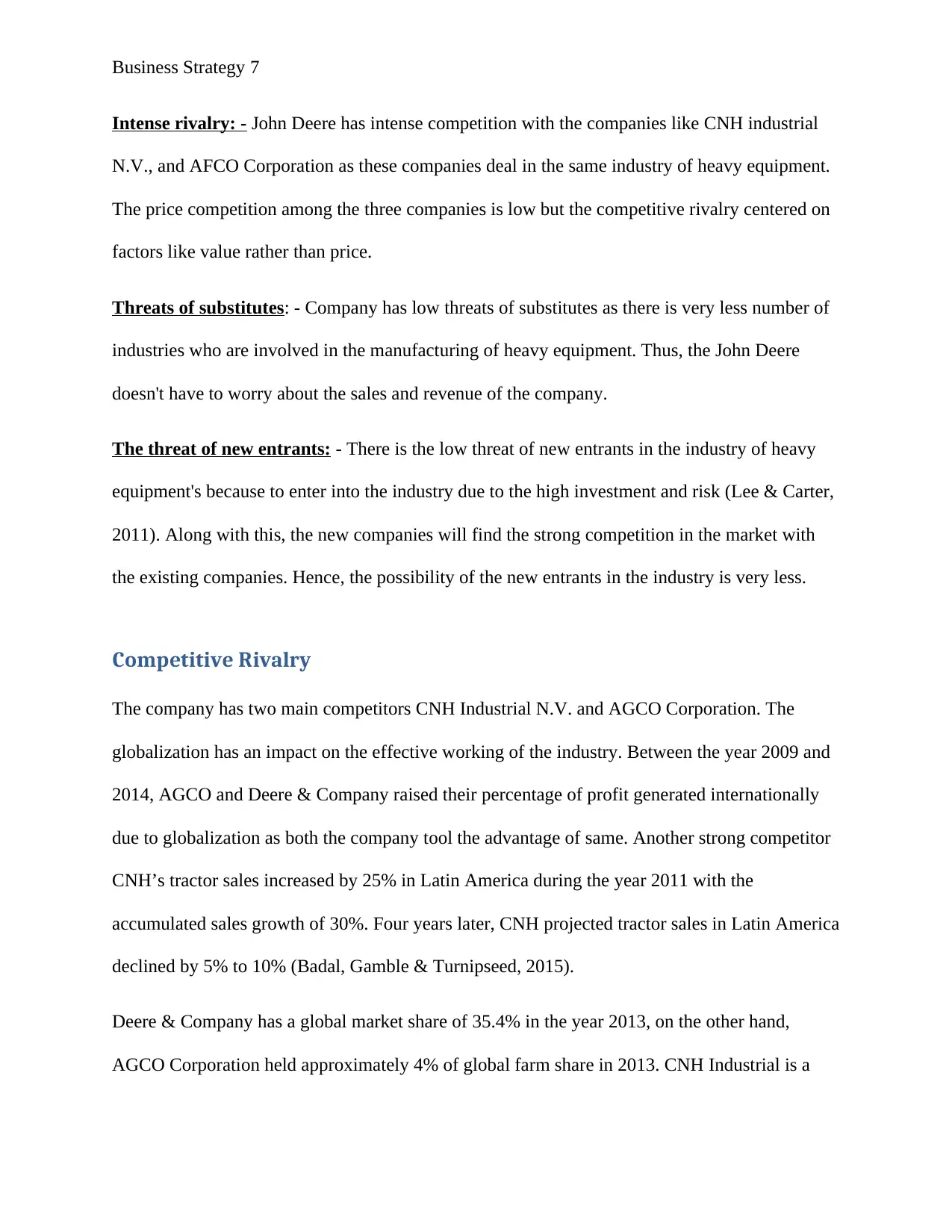
Business Strategy 7
Intense rivalry: - John Deere has intense competition with the companies like CNH industrial
N.V., and AFCO Corporation as these companies deal in the same industry of heavy equipment.
The price competition among the three companies is low but the competitive rivalry centered on
factors like value rather than price.
Threats of substitutes: - Company has low threats of substitutes as there is very less number of
industries who are involved in the manufacturing of heavy equipment. Thus, the John Deere
doesn't have to worry about the sales and revenue of the company.
The threat of new entrants: - There is the low threat of new entrants in the industry of heavy
equipment's because to enter into the industry due to the high investment and risk (Lee & Carter,
2011). Along with this, the new companies will find the strong competition in the market with
the existing companies. Hence, the possibility of the new entrants in the industry is very less.
Competitive Rivalry
The company has two main competitors CNH Industrial N.V. and AGCO Corporation. The
globalization has an impact on the effective working of the industry. Between the year 2009 and
2014, AGCO and Deere & Company raised their percentage of profit generated internationally
due to globalization as both the company tool the advantage of same. Another strong competitor
CNH’s tractor sales increased by 25% in Latin America during the year 2011 with the
accumulated sales growth of 30%. Four years later, CNH projected tractor sales in Latin America
declined by 5% to 10% (Badal, Gamble & Turnipseed, 2015).
Deere & Company has a global market share of 35.4% in the year 2013, on the other hand,
AGCO Corporation held approximately 4% of global farm share in 2013. CNH Industrial is a
Intense rivalry: - John Deere has intense competition with the companies like CNH industrial
N.V., and AFCO Corporation as these companies deal in the same industry of heavy equipment.
The price competition among the three companies is low but the competitive rivalry centered on
factors like value rather than price.
Threats of substitutes: - Company has low threats of substitutes as there is very less number of
industries who are involved in the manufacturing of heavy equipment. Thus, the John Deere
doesn't have to worry about the sales and revenue of the company.
The threat of new entrants: - There is the low threat of new entrants in the industry of heavy
equipment's because to enter into the industry due to the high investment and risk (Lee & Carter,
2011). Along with this, the new companies will find the strong competition in the market with
the existing companies. Hence, the possibility of the new entrants in the industry is very less.
Competitive Rivalry
The company has two main competitors CNH Industrial N.V. and AGCO Corporation. The
globalization has an impact on the effective working of the industry. Between the year 2009 and
2014, AGCO and Deere & Company raised their percentage of profit generated internationally
due to globalization as both the company tool the advantage of same. Another strong competitor
CNH’s tractor sales increased by 25% in Latin America during the year 2011 with the
accumulated sales growth of 30%. Four years later, CNH projected tractor sales in Latin America
declined by 5% to 10% (Badal, Gamble & Turnipseed, 2015).
Deere & Company has a global market share of 35.4% in the year 2013, on the other hand,
AGCO Corporation held approximately 4% of global farm share in 2013. CNH Industrial is a
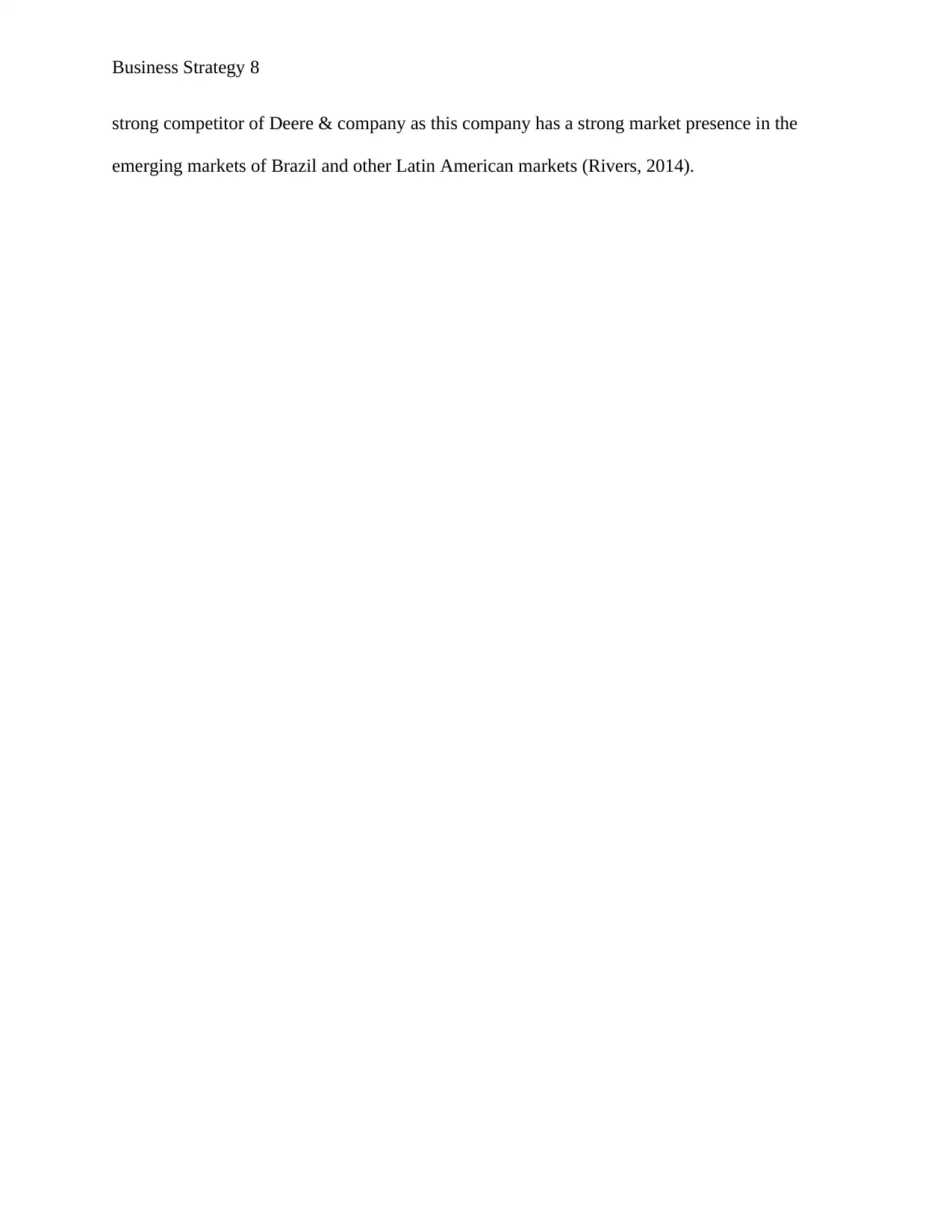
Business Strategy 8
strong competitor of Deere & company as this company has a strong market presence in the
emerging markets of Brazil and other Latin American markets (Rivers, 2014).
strong competitor of Deere & company as this company has a strong market presence in the
emerging markets of Brazil and other Latin American markets (Rivers, 2014).
⊘ This is a preview!⊘
Do you want full access?
Subscribe today to unlock all pages.

Trusted by 1+ million students worldwide
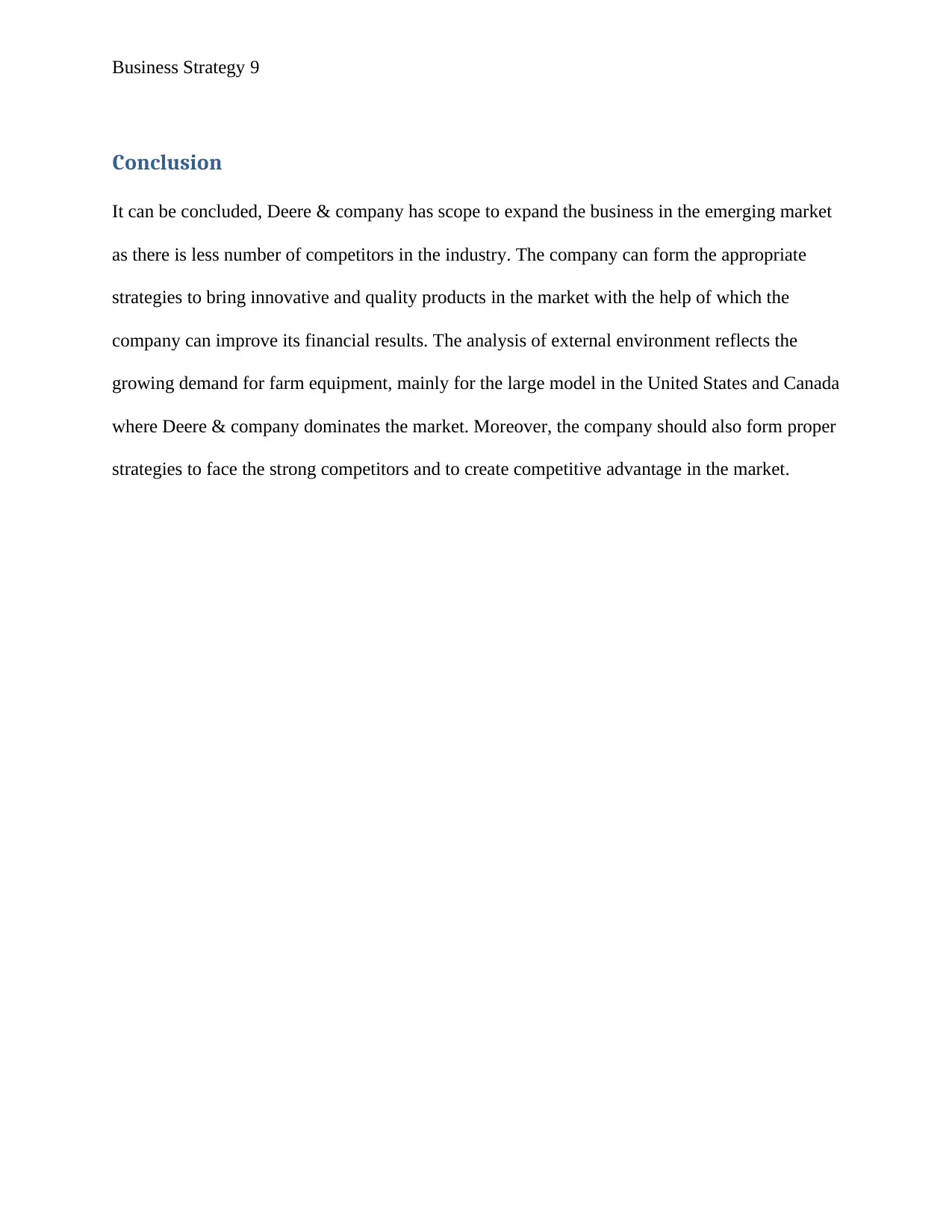
Business Strategy 9
Conclusion
It can be concluded, Deere & company has scope to expand the business in the emerging market
as there is less number of competitors in the industry. The company can form the appropriate
strategies to bring innovative and quality products in the market with the help of which the
company can improve its financial results. The analysis of external environment reflects the
growing demand for farm equipment, mainly for the large model in the United States and Canada
where Deere & company dominates the market. Moreover, the company should also form proper
strategies to face the strong competitors and to create competitive advantage in the market.
Conclusion
It can be concluded, Deere & company has scope to expand the business in the emerging market
as there is less number of competitors in the industry. The company can form the appropriate
strategies to bring innovative and quality products in the market with the help of which the
company can improve its financial results. The analysis of external environment reflects the
growing demand for farm equipment, mainly for the large model in the United States and Canada
where Deere & company dominates the market. Moreover, the company should also form proper
strategies to face the strong competitors and to create competitive advantage in the market.
Paraphrase This Document
Need a fresh take? Get an instant paraphrase of this document with our AI Paraphraser
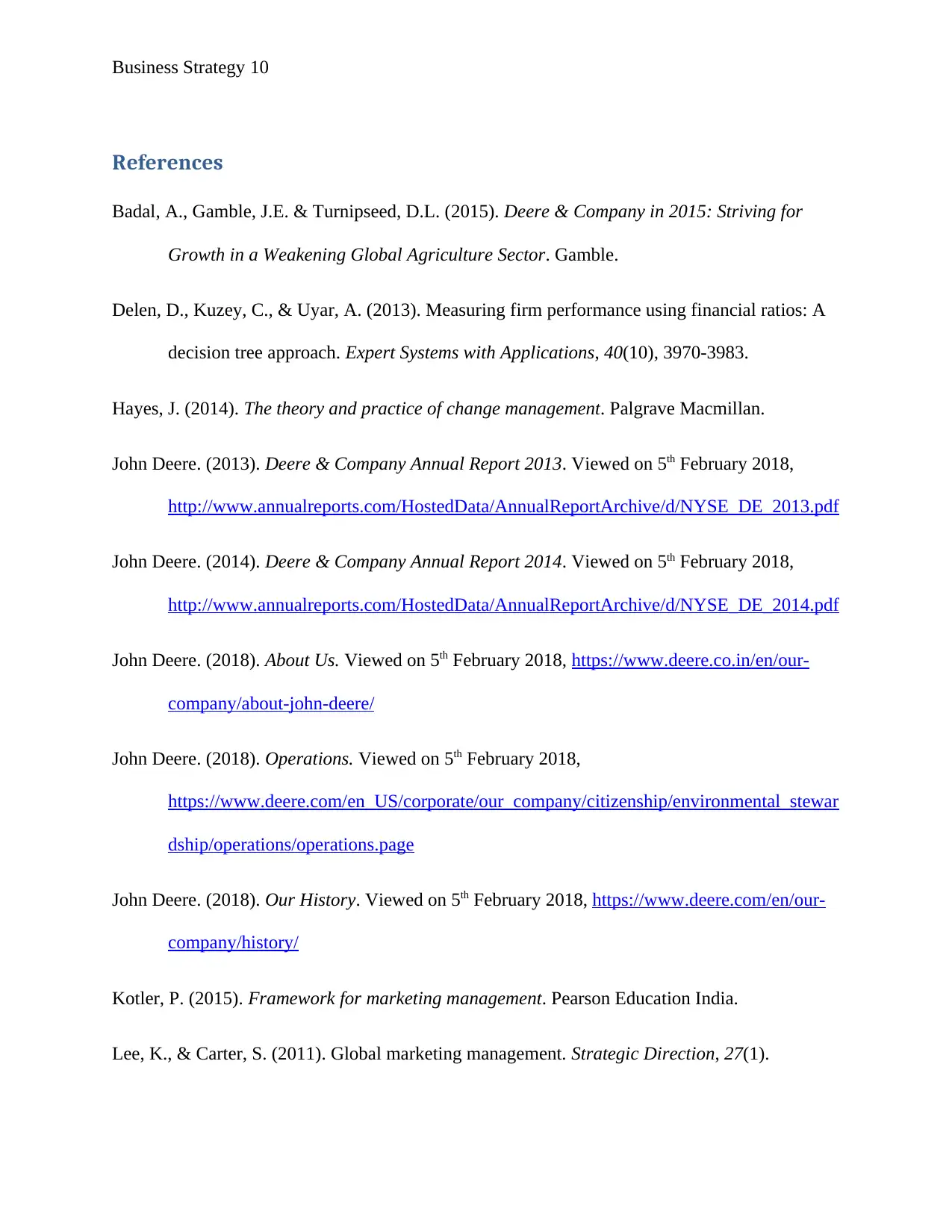
Business Strategy 10
References
Badal, A., Gamble, J.E. & Turnipseed, D.L. (2015). Deere & Company in 2015: Striving for
Growth in a Weakening Global Agriculture Sector. Gamble.
Delen, D., Kuzey, C., & Uyar, A. (2013). Measuring firm performance using financial ratios: A
decision tree approach. Expert Systems with Applications, 40(10), 3970-3983.
Hayes, J. (2014). The theory and practice of change management. Palgrave Macmillan.
John Deere. (2013). Deere & Company Annual Report 2013. Viewed on 5th February 2018,
http://www.annualreports.com/HostedData/AnnualReportArchive/d/NYSE_DE_2013.pdf
John Deere. (2014). Deere & Company Annual Report 2014. Viewed on 5th February 2018,
http://www.annualreports.com/HostedData/AnnualReportArchive/d/NYSE_DE_2014.pdf
John Deere. (2018). About Us. Viewed on 5th February 2018, https://www.deere.co.in/en/our-
company/about-john-deere/
John Deere. (2018). Operations. Viewed on 5th February 2018,
https://www.deere.com/en_US/corporate/our_company/citizenship/environmental_stewar
dship/operations/operations.page
John Deere. (2018). Our History. Viewed on 5th February 2018, https://www.deere.com/en/our-
company/history/
Kotler, P. (2015). Framework for marketing management. Pearson Education India.
Lee, K., & Carter, S. (2011). Global marketing management. Strategic Direction, 27(1).
References
Badal, A., Gamble, J.E. & Turnipseed, D.L. (2015). Deere & Company in 2015: Striving for
Growth in a Weakening Global Agriculture Sector. Gamble.
Delen, D., Kuzey, C., & Uyar, A. (2013). Measuring firm performance using financial ratios: A
decision tree approach. Expert Systems with Applications, 40(10), 3970-3983.
Hayes, J. (2014). The theory and practice of change management. Palgrave Macmillan.
John Deere. (2013). Deere & Company Annual Report 2013. Viewed on 5th February 2018,
http://www.annualreports.com/HostedData/AnnualReportArchive/d/NYSE_DE_2013.pdf
John Deere. (2014). Deere & Company Annual Report 2014. Viewed on 5th February 2018,
http://www.annualreports.com/HostedData/AnnualReportArchive/d/NYSE_DE_2014.pdf
John Deere. (2018). About Us. Viewed on 5th February 2018, https://www.deere.co.in/en/our-
company/about-john-deere/
John Deere. (2018). Operations. Viewed on 5th February 2018,
https://www.deere.com/en_US/corporate/our_company/citizenship/environmental_stewar
dship/operations/operations.page
John Deere. (2018). Our History. Viewed on 5th February 2018, https://www.deere.com/en/our-
company/history/
Kotler, P. (2015). Framework for marketing management. Pearson Education India.
Lee, K., & Carter, S. (2011). Global marketing management. Strategic Direction, 27(1).
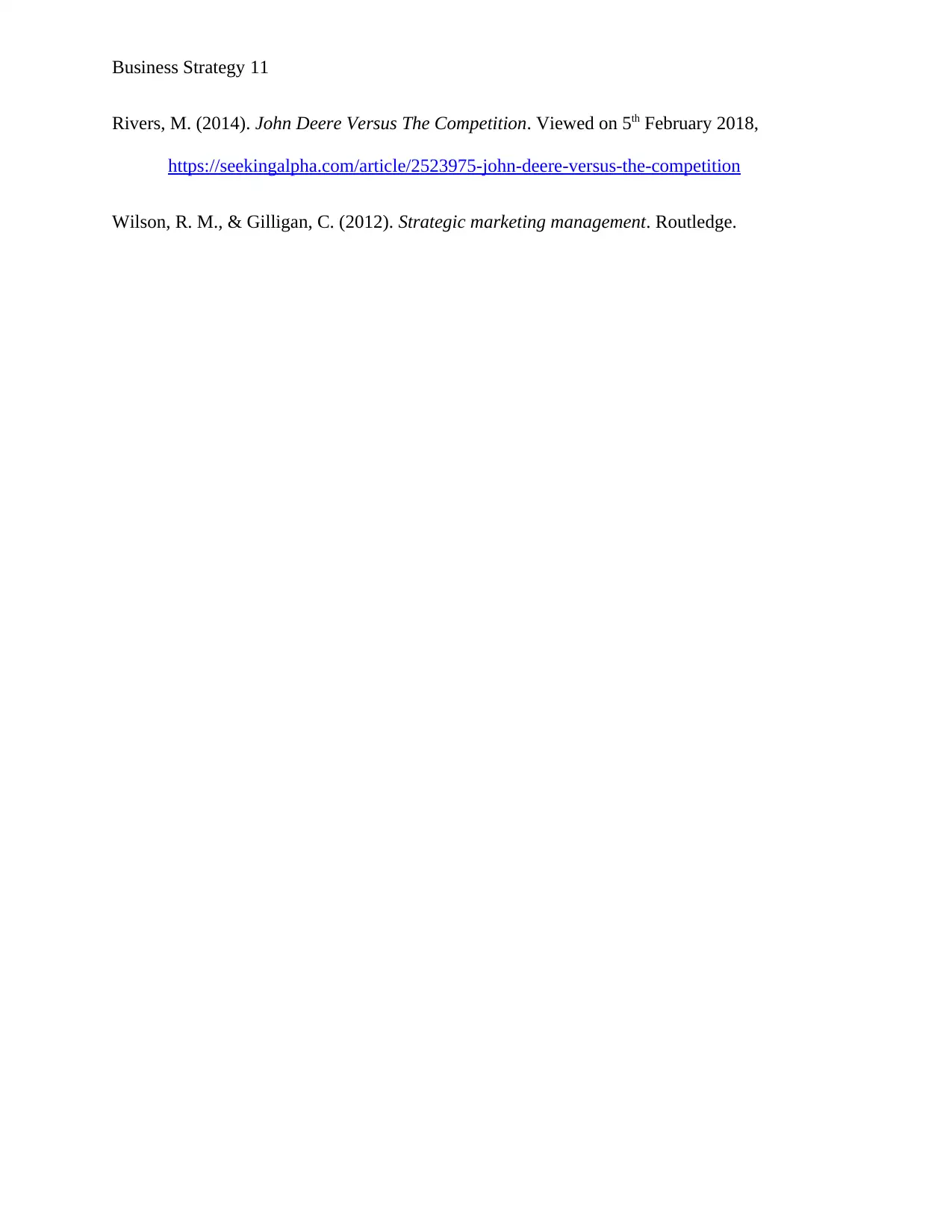
Business Strategy 11
Rivers, M. (2014). John Deere Versus The Competition. Viewed on 5th February 2018,
https://seekingalpha.com/article/2523975-john-deere-versus-the-competition
Wilson, R. M., & Gilligan, C. (2012). Strategic marketing management. Routledge.
Rivers, M. (2014). John Deere Versus The Competition. Viewed on 5th February 2018,
https://seekingalpha.com/article/2523975-john-deere-versus-the-competition
Wilson, R. M., & Gilligan, C. (2012). Strategic marketing management. Routledge.
⊘ This is a preview!⊘
Do you want full access?
Subscribe today to unlock all pages.

Trusted by 1+ million students worldwide
1 out of 13
Related Documents
Your All-in-One AI-Powered Toolkit for Academic Success.
+13062052269
info@desklib.com
Available 24*7 on WhatsApp / Email
![[object Object]](/_next/static/media/star-bottom.7253800d.svg)
Unlock your academic potential
Copyright © 2020–2025 A2Z Services. All Rights Reserved. Developed and managed by ZUCOL.




